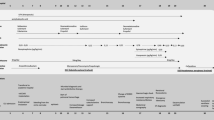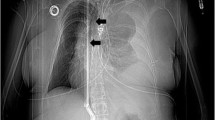Abstract
Spontaneous hemo-pneumothorax is one of the pulmonary complications of connective tissue disorders such as Ehlers–Danlos syndrome (EDS). Most thoracic surgeons overlook this fact and they consider it as primary. In the following report, we describe a unique case of spontaneous recurrent hemo-pneumothorax in a young patient with undiagnosed EDS. The aim of this presentation is to raise a high index of suspicion of every thoracic surgeon to include in his differential diagnosis, the connective tissue disorders in any case of spontaneous hemo-pneumothorax.
Similar content being viewed by others
Avoid common mistakes on your manuscript.
Introduction
Ehlers–Danlos syndrome (cutis hyperelastica) is a group of connective tissue disorders characterized by abnormalities of the skin, ligaments and internal organs. The frequency of this syndrome is reported to be 1 in 10,000 [1]. It is a hereditary syndrome, with autosomal dominant inheritance, that primarily affects the collagen synthesis. The skin and blood vessels are extremely fragile and elastic. The skin is soft and easily bruising. There are hypermobile joints with increased extensibility. Vascular-type EDS (VEDS) has the worst prognosis. Respiratory manifestations of VEDS, although not always common, have been described and include recurrent hemoptysis, bulla and bleb formation, and spontaneous pneumothoraces. Most frequent initial complication of VEDS is arterial dissection or colon rupture [2]. Although rare, VEDS patients can present at the hospital with pulmonary manifestations as an initial complication without evident vascular or colon complications. Here, we report a case of a young man who presented with pulmonary manifestations of VEDS. Our case is rare because the initial complication was limited to the lungs.
Case presentation
A 21-year-old man, student, non-smoker, was referred to our hospital with history of sudden onset of right chest pain, hemoptysis and breathlessness. There was no history of fever, cough, or trauma chest. He was not taking any medications. His parents were healthy and without vascular or skin disorders. There was history of sudden breathlessness 3 years back when X-ray chest revealed right-sided pneumothorax and he was managed conservatively with intercostal tube drainage at Disrict Hospital. Patient did not report back after being discharged from the hospital. On admission to our institute, height was 168 cm, body weight 45 kg, afebrile, hemodynamically stable, and respiratory rate 28 breaths per minute. On chest examination, the patient had decreased air entry in the right lung field. His skin was thin, elastic, and hyperextensible. The small joints of his extremities were hyperextensive (Fig. 1). Face was looking syndromic. A blood count revealed a white blood cell count of 7,300/μL, hemoglobin of 10.6 g/dL, and platelet count of 156,000/μL. Liver-function tests, erythrocyte sedimentation rate, and C-reactive protein level were within normal limits. A chest X-ray revealed a right hydro-pneumothorax with collapsed lung. A chest tube was inserted, and about 500 ml of blood was drained over the next 24 h. A Computerized Tomography (CT) scan of the chest performed after drainage showed right-sided pneumothorax with a significant collection (Fig. 2). Drainage through chest tube continued to be significant for the next 3 days. Right thoracotomy was performed on fourth day of admission. Findings at thoracotomy revealed a collapsed right lung and hematoma within the pleural cavity with air leakage from lower lobe. Complete hemostasis was ensured by securing small bleeders in right lower lobe. Wedge biopsy was taken from the lung. Patient had an uneventful postoperative recovery with re-expansion of right lung. The patient was discharged home on seventh postoperative day. Histopathology revealed filling of the alveolar spaces with cellular fibrous proliferation. There was increased fibrosis on the pleural surface with an increased vascularity. There was no associated interstitial chronic inflammation. The findings were similar to those seen in pulmonary manifestations of VEDS. A skin biopsy was taken for biochemical analysis of type III collagen from cultivated dermal fibroblasts. There was markedly reduced production of type III collagen in contrast to normal type I collagen production. Type III collagen gene COL3A1 analysis was then performed. A missense mutation in exon 29 of the COL3A1 gene from guanine to adenine was detected resulting in substitution of glycine for aspartic acid at amino acid position 603. At 6 months of follow-up, the patient is doing well.
Discussion
EDS is an uncommon inherited disorder of the connective tissue. Six types are classified by their clinical features: classical type, hypermobility type, vascular type, kyphoscoliosis type, arthrochalasia type, and dermatosparaxis type [3]. Vascular type Ehlers–Danlos syndrome (VEDS) is rare and accounting for 10 % of the Ehlers–Danlos variants. The underlying genetic mutation is that of COL3A1 gene, resulting in abnormalities in type III procollagen production and synthesis which is an important component of skin, blood vessels, and other organs. Type I and type III collagen are the major collagens in the lung and that the amount of type III collagen in the lungs of patients with VEDS is significantly lower than that of normal controls [4]. Lungs of VEDS patients are vulnerable to lacerate, which is suggested to manifest initially as acute hematoma, followed by organizing to organized hematoma. The diagnosis of VEDS is mainly clinical and can be confirmed biochemically by showing reduced type III collagen production by fibroblasts or through molecular analysis of the mutated COL3A1 gene [5, 6 ]. It should be noted that joint hypermobility in VEDS patients is less apparent than in patients with other types of EDS [7]. Our patient had joint hypermobility making this case a more rare one. VEDS has the worst prognosis of all types of EDS. Rupture of the frail walls of the medium-sized abdominal arteries, sigmoid colon and pregnant uterus can result in sudden death. Management of patients with VEDS is difficult because there is no specific treatment. Vascular complications are generally sudden. Patients should be genetically counselled and warned about the associated risks of the syndrome. Pepin et al. [2] reported that most of the initial complications in VEDS patients were arterial dissection or rupture (65.4 %) or gastrointestinal rupture (30.1 %). Initial complications stemming from other organs were seen in only 5 % of cases. In the present case, the initial complication was spontaneous pneumothorax, and vascular complications occurred 3 years after the initial pulmonary complication. To our knowledge, only few cases of patients developing pulmonary symptoms as an initial manifestation have been reported [8, 9].
Conclusion
VEDS is a rare but serious disease. Patients may present with spontaneous hemo or pneumothoraces. Surgery is technically demanding as tissues are potentially friable. In the long term, genetic counselling is a priority, especially in females, as the risks of pregnancy are high, and referral to a specialist is advocated. Thoracic surgeons and respiratory physicians should be aware of the possible pulmonary presentations of connective tissue disorders and arrange appropriate investigations and specialist referrals when such patients present.
References
Abel MD, Carrasco LR. Ehlers–Danlos syndrome: classifications, oral manifestations, and dental considerations. Oral Surg Oral Med Oral Pathol Oral Radiol Endod. 2006;102:582–90.
Pepin M, Schwarze U, Superti-Furga A, Byers PH. Clinical and genetic features of Ehlers–Danlos syndrome type IV, the vascular type. N Engl J Med. 2000;343:366–8. (Erratum in: N Engl J Med 343: 366–368, 2000).
Beighton P, De Paepe A, Steinmann B, Tsipouras P, Wenstrup RJ, Ehlers–Danlos syndromes: revised nosology, Villefranche. Ehlers–Danlos National Foundation (USA) and Ehlers–Danlos Support Group (UK). Am J Med Genet. 1997;88(31–37):1998.
Clark JG, Kuhn C, Uitto J. Lung collagen in type IV Ehlers–Danlos syndrome: ultrastructural and biochemical studies. Am Rev Respir Dis. 1980;122:971–8.
Richards AJ, Lloyd JC, Ward PN, De PA, Narcisi P, Pope FM. Characterisation of a glycine to valine substitution at amino acid position 910 of the triple helical region of type III collagen in a patient with Ehlers–Danlos syndrome type IV. J Med Genet. 1991;28:458–63.
Richards AJ, Lloyd JC, Narcisi P, Ward PN, Nicholls AC, De PA, et al. A 27-bp deletion from one allele of the type III collagen gene (COL3A1) in a large family with Ehlers–Danlos syndrome type IV. Hum Genet. 1992;88:325–30.
Narcisi P, Wu Y, Tromp G, Earley JJ, Richards AJ, Pope FM, et al. Single base mutation that substitutes glutamic acid for glycine 1021 in the COL3A1 gene and causes Ehlers–Danlos syndrome type IV. Am J Med Genet. 1993;46:278–83.
Watanabe A, Kawabata Y, Okada O. Ehlers–Danlos syndrome type IV with few extrathoracic findings: a newly recognized point mutation in the COL3A1 gene. Eur Respir J. 2002;19:195–8.
Sareli AE, Janssen WJ, Sterman D, Saint S, Pyeritz RE. Clinical problem-solving. What’s the connection?—a 26-year-old white man presented to our referral hospital with a 1-month history of persistent cough productive of white sputum, which was occasionally tinged with blood. N Engl J Med. 2008;358:626–32.
Author information
Authors and Affiliations
Corresponding author
Rights and permissions
About this article
Cite this article
Dar, R.A., Wani, S.H., Mushtaque, M. et al. Spontaneous hemo-pneumothorax in a patient with Ehlers–Danlos syndrome. Gen Thorac Cardiovasc Surg 60, 587–589 (2012). https://doi.org/10.1007/s11748-012-0047-x
Received:
Accepted:
Published:
Issue Date:
DOI: https://doi.org/10.1007/s11748-012-0047-x






